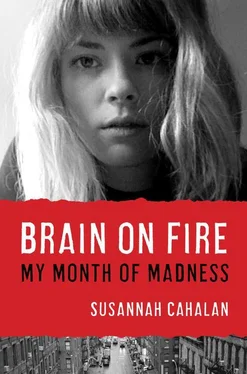When I contacted her about my research, Dr. Dalmau’s colleague Dr. Rita Balice-Gordon brought up the old Indian proverb, often used by neuroscientists studying the brain, about six blind men trying to identify an elephant, offering it as a way of understanding how much more we have to learn about the disease.
Each man grabs hold of a different part of the animal and tries to identify the unnamed object. One man touches the tail and says, “rope”; one touches a leg and says, “pillar”; one feels a trunk and says, “tree”; one feels an ear and says, “fan”; one feels the belly and says, “wall”; the last one feels the tusk and is certain it’s a “pipe.” (The tale has been told so many times that the outcomes differ widely. In a Buddhist iteration, the men are told they are all correct and rejoice; in another, the men break out in violence when they can’t agree.)
Dr. Balice-Gordon has a hopeful interpretation of the analogy: “We’re sort of approaching the elephant from the front end and from the back end in the hopes of touching in the middle. We’re hoping to paint a detailed enough landscape of the elephant.”
Two particular fields of study, schizophrenia and autism, will likely gain the most from this landscaping of the elephant. Dr. Balice-Gordon believes that a percentage, albeit a small one, of those diagnosed with autism and schizophrenia might in fact have an autoimmune disease. Many children ultimately diagnosed with anti-NMDA autoimmune encephalitis were first determined to be autistic. How many children originally diagnosed with autism weren’t able to find their autoimmune diagnosis?
As she explained, out of a hypothetical 5 million people diagnosed with autism, 4,999,000 of them might indeed be autistic. But what about that tiny slice that in fact have anti-NMDA-receptor encephalitis or one of the other related disorders, and could be effectively treated by looking for a peripheral tumor or antibodies in the brain?
The same goes for schizophrenia. Many of the adults ultimately diagnosed with anti-NMDA-receptor autoimmune encephalitis first receive the diagnosis of schizophrenia (or other related mental disorders, such as schizoaffective disorder, in my case). Statistically there must be some people who receive a diagnosis of psychosis or schizophrenia and never get the proper help. Even if it’s only 0.01 percent of patients, it’s still too many.
Unfortunately, for most people suffering from severe psychiatric conditions, it’s nearly impossible to give everyone the proper testing to diagnose and treat autoimmune diseases. PET scans, CT scans, MRIs, IVIG treatment, and plasmapheresis can cost upwards of thousands of dollars each.
“How practical would this screening be?” asks professor of psychology Philip Harvey. “Lumbar punctures for everyone? That’s an impossibility.”
It had cost $1 million to treat me, a number that boggles the mind. Luckily, at the time I was a full-time employee at the Post, and my insurance covered most of the exorbitant price tag. I also had a support system in place. My family was in the fortunate situation of being able to pay out of pocket anything that the insurance company wouldn’t cover or reimburse. Unfortunately, there’s often not the same safety net in place for those with lifelong psychiatric conditions, who are unable to hold jobs and must make do with disability payments and Medicaid.
But this is all the more reason that psychiatrists and neurologists are finding ways to break down the barriers set in place between psychology and neurology, urging for one uniform look at mental illnesses as the neurochemical diseases that they are, and, in the process, perhaps getting more grant money to study the overlap.
“One thought is that this is just a coincidence, that [NMDA-receptor encephalitis] and schizophrenia are unrelated. But Mother Nature doesn’t work that way. The best hypothesis for schizophrenia is that at least some of those cases can also be explained by a [similar] dysfunction,” said Dr. Balice-Gordon.
Dr. Najjar, for one, is taking the link between autoimmune diseases and mental illnesses one step further: through his cutting-edge research, he posits that some forms of schizophrenia, bipolar disorder, obsessive-compulsive disorder, and depression are actually caused by inflammatory conditions in the brain.
Dr. Najjar is in the midst of groundbreaking work that might finally sever the barrier separating immunology, neurology, and psychiatry. A recent case of his centers on a nineteen-year-old woman who had been diagnosed with schizophrenia by six leading psychiatrists over the course of two years. 56When she was seventeen, her symptoms began with auditory hallucinations—“people putting me down and thinking they’re better than I am,” she told Dr. Najjar—followed by visual ones. Late at night, she would see “people’s faces on the walls.”
Her parents did not believe the schizophrenia diagnosis and eventually made their way to New York University, where they met with Dr. Najjar. He ordered a right frontal brain biopsy—something he had learned from my case—that showed the presence of inflammation and antibodies targeting the glutamate receptors in the brain. She was treated with steroids, plasma exchange, and IVIG treatment, which helped with the hallucinations and paranoia, but because the treatment was started so late, it is unclear if she ever will return to her former self.
“Just because it seems like schizophrenia doesn’t mean that it is,” Dr. Najjar told me. “We have to keep humble and keep our eyes open.”
As I researched my article, I was curious to get the perspective of Dr. Bailey, the neurologist who had asserted that my problems stemmed from alcohol withdrawal and stress, to see what he thought about the ultimate diagnosis. When I reached him by phone, though, it turned out he still had never heard of the illness, even though my diagnosis had been discussed in almost every major medical journal, including the New England Journal of Medicine, and the New York Times.
In the spring of 2009, I was the 217th person ever to be diagnosed with anti-NMDA-receptor autoimmune encephalitis. Just a year later, that figure had doubled. Now the number is in the thousands. Yet Dr. Bailey, considered one of the best neurologists in the country, had never heard of it. When we live in a time when the rate of misdiagnoses in the United States has shown no improvement since the 1930s, the lesson here is that it’s important to always get a second opinion. 57
While he may be an excellent doctor in many respects, Dr. Bailey is also, in some ways, a perfect example of what is wrong with medicine. I was just a number to him (and if he saw thirty-five patients a day, as he told me, that means I was one of a very large number). He is a by-product of a defective system that forces neurologists to spend five minutes with X number of patients a day to maintain their bottom line. It’s a bad system. Dr. Bailey is not the exception to the rule. He is the rule.
I’m the one who is an exception. I’m the one who is lucky. I did not slip through a system that is designed to miss cases just like my own—cases that require time and patience and individualized attention. Sure, when I talked to him, I was shocked that he knew nothing about the disease, but that wasn’t the really shocking part; I realize now that my survival, my recovery—my ability to write this book—is the shocking part.
Yet even after all of this, the most harrowing part of researching and writing the article about my illness was something that I had in no way prepared for: handing over the EEG tapes to my paper’s photo editor, who wanted to use some images of me in the hospital for the piece. I hadn’t yet watched them and at that point did not plan to.
Читать дальше













